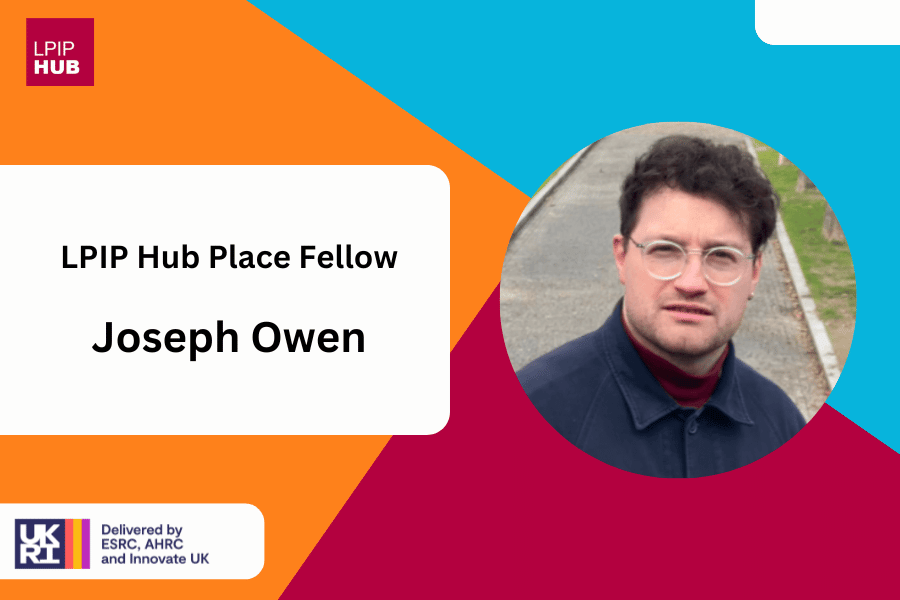Isaac Fravashi is a researcher, poet, and artist, who has been working with Feeling Towns to explore how collage can be used to plot these social, emotional and cultural landscapes.
Top-down policymaking can impede public engagement if communities feel their values are not being acknowledged (Paschen and Ison). Numerous studies demonstrate that the policies and actions of public bodies are truly transformative when aligned with the values, priorities and cultures of hyperlocal communities (Marks et al.; Barnett et al.; Adger et al.).
Community consultation and citizen-centred approaches to planning can increase public commitment and achieve robust change that better serves the people it concerns. It is therefore fundamental that culture-led regeneration is shaped by voices of the community. However, the necessary step of public engagement in the policy-making process is often viewed as an inconvenient obstruction to the work of public bodies (Ojha et al.).
Yet recent studies into creative methodologies have discovered routes of consultation that can tease out the nuances of community-specific values and place-based identities, which citizen support hinges upon (Tschakert et al.).
As a researcher, poet, and artist, I have been working with Feeling Towns to explore how collage can be used to plot these social, emotional and cultural landscapes. In partnership with Isle of Wight Council and Dorchester Town Council, we have used a series of collage poetry workshops to uncover how local communities relate to the places where they live, work and play.

Although, for many of us, the word “collage” brings back memories of blunted classroom scissors and sticky fingers, the art form’s accessibility and simplicity makes it ideal for teachers and researchers alike (Butler-Kisber). Collage has been used in many different settings: helping Gulf War veterans articulate their experience (Malhotra et al.); connecting with First Nation Inuit communities (Dutton et al.); and even conducting consumer research in contested West Bank territories (Bröckerhoff and Seregina).
People often find it easier to engage in complex conversations when the interactions are channelled towards creativity (Malchiodi). In our workshops, collage poetry was particularly helpful: the focus on language directed participants towards articulating their thoughts; while the physicality and creative arrangement of the method encouraged play.
This playfulness set the tone for conversation during the workshop and in the analysis of the poem that followed. Expanding from the juxtaposition of poetic responses they had written, participants made jokes about their opinions and playfully explored each other’s perspectives.
Rather than participating in a battleground of political contentiousness, people were able to think about their town cooperatively, finding common ground and exploring disagreements with an open curiosity to seek mutual resolution.
In this context, the collage poetry method puts ‘ideas in line of sight with each other, which can imply or suggest collaboration … even if there is no established reason for those bits and pieces to come together. Suddenly another way of seeing the world is possible’ (Walters). In community consultations, researchers can see similar dynamics building, where participants become ‘co-generators of knowledge’ (Dutton et al.).
In this way, communities are able to shape their own values and priorities. By making meaning through juxtaposition, participants offer multifarious and nuanced images of place-identity that might seem contradictory if reduced to a single expression.

In one workshop, Dorchester was described as a garden that was ‘struggling yet thriving’, a description that seems paradoxical and precludes interpretation. But by rearranging the responses, participants developed an extended metaphor in which the garden of Dorchester was ‘uncannily neat’ in areas where a ‘generic’ gardener managed it, but ‘full of wildflowers’ where the community had worked on it together.
One reading of these lines might suggest that Dorchester is ‘neat’ when it is managed by a single generic body and ‘wild’ when it is left to the public. Another reading suggests that participants feel Dorchester is ‘struggling’ when ‘generic’ methods of organisation are used, but small pockets of wild beauty arise when ‘the whole community look after it’. The poem offers up a place of apparent contradiction, which in fact suggests possible routes to resolution and, most potently, leaves us with a question:
What would happen if the gardener and the community worked together?
Bibliography
Adger, W. Neil, et al. ‘Climate Change Affects Multiple Dimensions of Well-Being through Impacts, Information and Policy Responses’. Nature Human Behaviour, vol. 6, no. 11, Nov. 2022, pp. 1465–73. DOI.org (Crossref), https://doi.org/10.1038/s41562-022-01467-8.
Barnett, Jon, et al. ‘Three Ways Social Identity Shapes Climate Change Adaptation’. Environmental Research Letters, vol. 16, no. 12, Dec. 2021, p. 124029. DOI.org (Crossref), https://doi.org/10.1088/1748-9326/ac36f7.
Bröckerhoff, Aurélie, and Usva Seregina. ‘Sticking Pieces Together – Representing Messiness in Consumer Research through the Use of Collage’. Journal of Marketing Management, vol. 38, no. 15–16, Oct. 2022, pp. 1727–55. DOI.org (Crossref), https://doi.org/10.1080/0267257X.2022.2144416.
Butler-Kisber, Lynn. ‘Collage as Inquiry’. Handbook of the Arts in Qualitative Research: Perspectives, Methodologies, Examples, and Issues, edited by J. Gary Knowles and Ardra L. Cole, Sage Publications, 2008, pp. 265–76.
Dutton, S., et al. ‘Biographical Collage as a Tool in Inuit Community-Based Participatory Research and Capacity Development’. International Journal of Qualitative Methods, vol. 18, Jan. 2019, p. 160940691987730. DOI.org (Crossref), https://doi.org/10.1177/1609406919877307.
Malchiodi, Cathy A. ‘Creative Arts Therapies and Arts‑based Research.’ Handbook of Arts-Based Research., The Guilford Press, 2018, pp. 68–87.
Malhotra, Bani, et al. ‘Collage-Based Graphic Elicitation Method for Capturing the Lived Experiences of Veterans with Gulf War Illness’. Life Sciences, vol. 284, Nov. 2021, p. 119656. DOI.org (Crossref), https://doi.org/10.1016/j.lfs.2021.119656.
Marks, Danny, et al. ‘Towards a Cultural Lens for Adaptation Pathways to Climate Change’. Regional Environmental Change, vol. 22, no. 1, Mar. 2022, p. 22. DOI.org (Crossref), https://doi.org/10.1007/s10113-022-01884-5.
Ojha, Hemant R., et al. ‘Policy without Politics: Technocratic Control of Climate Change Adaptation Policy Making in Nepal’. Climate Policy, vol. 16, no. 4, May 2016, pp. 415–33. DOI.org (Crossref), https://doi.org/10.1080/14693062.2014.1003775.
Paschen, Jana-Axinja, and Ray Ison. ‘Narrative Research in Climate Change Adaptation—Exploring a Complementary Paradigm for Research and Governance’. Research Policy, vol. 43, no. 6, July 2014, pp. 1083–92. DOI.org (Crossref), https://doi.org/10.1016/j.respol.2013.12.006.
Tschakert, P., et al. ‘One Thousand Ways to Experience Loss: A Systematic Analysis of Climate-Related Intangible Harm from around the World’. Global Environmental Change, vol. 55, Mar. 2019, pp. 58–72. DOI.org (Crossref), https://doi.org/10.1016/j.gloenvcha.2018.11.006.



